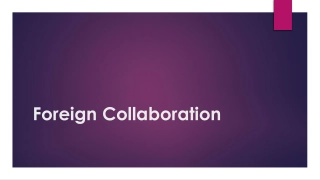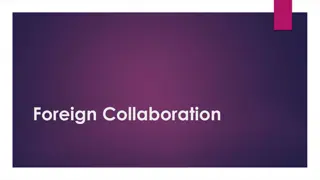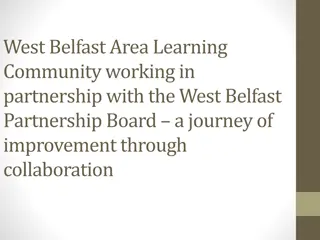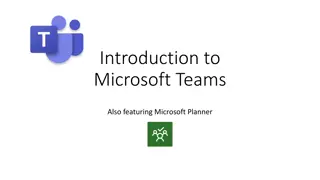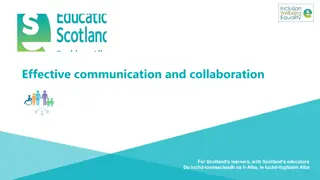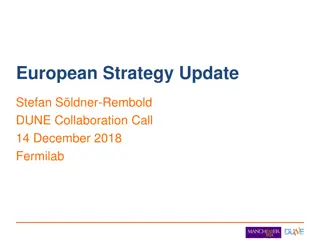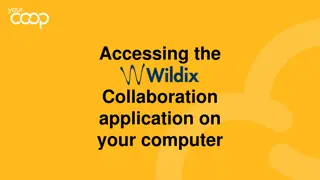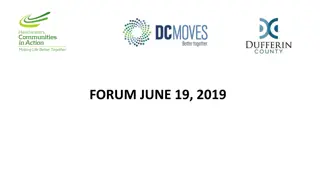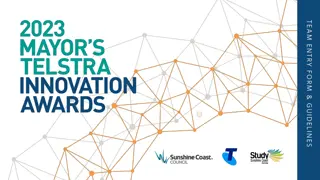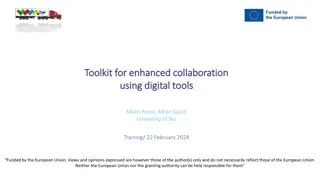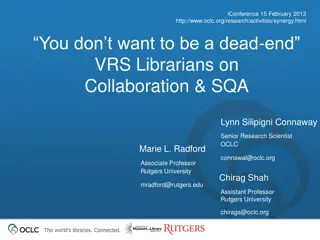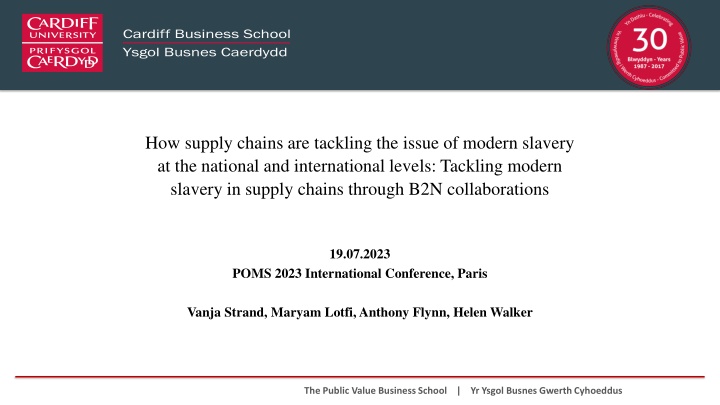
Tackling Modern Slavery in Supply Chains Through Collaboration
Explore how businesses and NGOs collaborate to address modern slavery in supply chains, examining enablers, barriers, and research gaps. Gain insights into the social sustainability aspects and definitions of modern slavery. Learn about the significant challenges and opportunities in combating this pressing issue at national and international levels.
Download Presentation

Please find below an Image/Link to download the presentation.
The content on the website is provided AS IS for your information and personal use only. It may not be sold, licensed, or shared on other websites without obtaining consent from the author. If you encounter any issues during the download, it is possible that the publisher has removed the file from their server.
You are allowed to download the files provided on this website for personal or commercial use, subject to the condition that they are used lawfully. All files are the property of their respective owners.
The content on the website is provided AS IS for your information and personal use only. It may not be sold, licensed, or shared on other websites without obtaining consent from the author.
E N D
Presentation Transcript
How supply chains are tackling the issue of modern slavery at the national and international levels: Tackling modern slavery in supply chains through B2N collaborations 19.07.2023 POMS 2023 International Conference, Paris Vanja Strand, Maryam Lotfi, Anthony Flynn, Helen Walker The Public Value Business School | Yr Ysgol Busnes Gwerth Cyhoeddus
Sustainability and modern slavery Social sustainability is the management of practices, capabilities, stakeholders and resources to address human potential and welfare both within and outside the communities of the supply chain (Nakamba et al., 2017, Sodhi and Tang, 2018). Social sustainability has received less attention than other forms of sustainability. Modern slavery can be seen as a branch in the socially sustainable supply chain literature and is an important phenomenon to explore in order to advance the field of supply chain management (Benstead et al. 2020). It is estimated that 50 million people were subjected to modern slavery every day in 2021, and that 28 million of them are subjected to forced labour (ILO and Walk Free Foundation 2023). Modern slavery generates 150 billion USD of illegal profits annually and 468 billion USD of G20 imports are goods are at risk of modern slavery (ILO 2014; ILO and Walk Free Foundation 2023). 2
Definition Modern slavery in business context is argued to usually manifest in the form of forced labour, debt bondage and human trafficking (Crane et al. 2021, p. 1). In the field of supply chain management, modern slavery is defined as the exploitation of a person who is deprived of individual liberty anywhere along the supply chain from raw material extraction to the final customer for service provision or production (Gold et al. 2015). This research will use the definition of Gold et al. (2015) but will also include the human supply chain (rather than stopping at raw material extraction/product supply chain) to account for workers that are facing exploitation through recruitment(Crane et al. 2021; Van Buren et al. 2021). The definition put forward of modern slavery in supply chains is as follows; The exploitation of a person who is deprived of individual liberty anywhere along the product or labour supply chain from recruitment to the final customer for service provision or production. 3
SLR - Gaps and avenues for future research The SLR on modern slavery in supply chains identified gaps and avenues for future research. Some of the gaps identified were: Lack of primary data. Lack of theoretical underpinning. Limited research on the involvement of third parties, such as NGOs, in tackling the issue of modern slavery in supply chains. Limited research on collaborative efforts in tackling the issue of modern slavery in supply chains. 4
Research questions 1. Why are businesses and NGOs (non-governmental organisations) collaborating in tackling modern slavery in supply chains? 2. How do businesses and NGOs collaborate in tackling modern slavery in supply chains? 3. What are the enablers and barriers of B2N (business and NGO) collaboration on tackling modern slavery in supply chains? 5
B2N collaboration A literature review was conducted on business-NGO collaborative efforts with regards to (social) sustainability and modern slavery. Supply chain collaboration has been defined as multiple firms or autonomous business entities engaging in a relationship that aims to share improved outcomes and benefits (Soosay and Hyland, 2015). Most research on B2N collaboration is focused on environmental collaboration, rather than social sustainability issues (Benstead et al. 2020). There are generally two strategies used in B2N relationships; cooperation (compliance monitoring) and confrontation ( watchdog approach) (Laasonen et al., 2012; Harangoz and Zilahy, 2015 Sethi and Rovenpor, 2016). B2N relationships can also be formed alongside other stakeholders, through multi-stakeholder initiatives. 6
Theoretical underpinning Dyer and Singh (1998) expand on industry structure view and the resource-based view by proposing the relational view. Organisations critical resources can extend beyond the organisations boundaries and also extend to inter-firm resources and routines. Such inter-firm relations are assumed to be more efficient arrangements for achieving a resource-based advantage than single firms (Lotfi et al., 2022). The relational view considers enablers and barriers for successful collaboration. It is a suitable theoretical underpinning for collaborative research (Walker et al., 2013). Future research on the relational view should apply the theory in new contexts, such as different types of partners e.g., NGOs (Benstead et al., 2018; Tate et al., 2022). 7
Methodology Qualitative empirical investigation through 20+ semi-structured interviews with business and NGO representatives working directly with the collaborative efforts. Unit of analysis Collaboration Unit of observation NGOs Businesses Former employee with personal knowledge of the NGO perspective Employee with personal knowledge of the business perspective Former employee with personal knowledge of the business perspective Employee with personal knowledge of the NGO perspective Unit of sampling B2N collaboration was identified through well-known modern slavery NGO websites. The businesses listed on the NGO websites, and the NGOs themselves, were contacted. The snowball method was applied through multiple means. 8
Methodology Carrying out primary research on modern slavery in supply chains is notoriously difficult (Meehan and Pinnington, 2021). So far, 22 participants have been interviewed, 6 NGO representatives and 16 business representatives. 4 other potential participants have showed interest. NGO representative role title Consultant; Advisor; Director; CEO; CEO; Head Business representative role title Manager; Manager; Senior Manager; Senior Manager; Leader; Manager; Specialist; Manager; Director; Head; Leader; Director; Manager; Senior Manager; Senior Manager; Manager Role of research participants (potential identifying title words redacted, e.g., sustainability or modern slavery) NVivo will be used to help with the analysis. 9
NGOs and businesses included Non-governmental organisations: An NGO is defined as an organization that tries to achieve social or political aims but is not controlled by a government although they may receive government funding (Cambridge Dictionary 2023). It became clear as the interviews were conducted, that NGOs in the sphere could fall outside what would normally constitute an NGO, but still provide/gain the same collaborative resources. NGOs can in theory be any organisation which is not governmental, and due to the difficulty of acquiring research participants a semi-wide view was taken of what constitutes an NGO. Hence, NGO participants in this study included charities, non-profits, not-for-profits, and social enterprises, which all worked to tackle modern slavery in supply chains by collaborating with business entities. Business organisations: Business organisations included anything from multi-national corporations to SMEs (small-medium enterprises), they could be private and public business entities, and they were not sector specific e.g., multi-sector, single sector (manufacture, agriculture, banking, technology). 10
Initial findings (examples) Why do they collaborate: NGOs would collaborate with businesses because businesses have a lot of leverage with government, suppliers and other important stakeholders. The financial resources of the collaboration was also one of the main incomes for a lot of the NGOs (especially social enterprises). Businesses would collaborate with NGOs because NGOs could provide businesses with expert knowledgethat they did not necessarily have. It was also seen as the right thing to do and could provide businesses with reputational benefits. How do they collaborate: Collaboration could be anything from dyad collaboration to multi-stakeholder initiatives, through formal or informal structures. They could collaborate by NGOs providing training to employees/suppliers, help with due diligence measures and risk assessments, facilitate for discussion and sharing of best practice through multi- stakeholder initiatives. An interesting example of shared collaboration is when businesses provide data to NGOs which can benefit them, and they will in turn analyse the data for the business. 11
Initial findings (examples) Benefits: Both business and NGO representatives appreciate a critical friend . A critical friend approach can go both ways in the collaboration. NGOs will provide businesses with solutions to fix the problems, and businesses can critically comment on new approaches and policies NGOs seek to introduce. There is also an upwards trajectory of investor engagement. Investor involvement means more attention from top management and more funding to spend on due diligence measures to tackle the issue of modern slavery in supply chains. Challenges: Businesses lack trust in NGOs way of operating. Businesses believe that NGOs do not understand business , hence do not appreciate the trade-offs firms have to make between commercial survival and sustainability. There is a distinction between NGOs that work as a charity and NGOs that work as a social enterprise. Social enterprises were often preferred (e.g., because they were not be influenced by Government agendas, seen as more likely to understand business practices). 12
Limitations The empirical data collection, through semi-structured interviews, will have its limitations. Qualitative data collection methods are often scrutinised due to different narratives or underlying bias of interviewer and interviewee (Silverman, 2021). There will be attempts made to minimize these limitations (e.g., send transcriptions to participants). There will also be data collection limitations. It is difficult to collect data due to modern slavery being a sensitive area. Another limitation is that the research focus on a UK presence. This is likely due to the institutional pressures because of modern slavery legislation. Future research could look at other contexts. 13
Contribution to research The paper contributes to the field of social sustainability and modern slavery in supply chains in different ways. Research on modern slavery in supply chains is scarce, which is partly due to the difficulty in accessing appropriate and particularly primary data on the topic (Caruana et al., 2021, Meehan and Pinnington, 2021). This gap is addressed by conducting interviews with informants from industry and NGOs. Little is known of B2N collaborative efforts, although they are prominent in this field, and academics have therefore called for research on B2N collaborative efforts to tackle modern slavery in supply chains (Benstead et al., 2018). This gap is addressed by focusing on B2N collaboration. The paper also employs relational theory as part of investigating B2N collaborations for tackling modern slavery in supply chains, which helps to expand on the theoretical grounding to this emerging line of inquiry, another gap found through the SLR. 14
Practical implications This study will have practical implications for businesses, with regards to how they deal with modern slavery in their supply chains and how they can improve their collaboration with other stakeholders. Non-governmental organisations can push forward change and work with businesses to improve B2N collaboration and thus supply chain management of modern slavery. People with lived experiences of modern slavery can also benefit from this study, if the other stakeholders use the findings to improve their supply chain management. Academia will gain value from rigorous research in the discipline of modern slavery, supply chain management and B2N collaboration. 15
References Benstead, A. V. et al. 2018. Horizontal collaboration in response to modern slavery legislation: An action research project. International Journal of Operations & Production Management 38(12), pp. 2286-2312. Gold, S. et al. 2015. Modern slavery challenges to supply chain management. Supply Chain Management-an International Journal 20(5), pp. 485-494. Lotfi, M. et al. 2022. A relational view of horizontal collaboration among micro and small enterprises: a study of the brewery sector in Wales. British food journal. 124(4), pp. 1254-1273. Benstead, A. V. et al. 2021. Detecting and remediating modern slavery in supply chains: a targeted audit approach. Production Planning & Control 32(13), pp. 1136-1157. Caruana, R. et al. 2021. Modern Slavery in Business: The Sad and Sorry State of a Non- Field. Business & Society 60(2), pp. 251-287. New, S. J. 2015. Modern slavery and the supply chain: the limits of corporate social responsibility? Supply Chain Management-an International Journal 20(6), pp. 697-707. Crane, A. 2013. Modern Slavery as a Management Practice: Exploring the Conditions and Capabilities for Human Exploitation. Academy of Management Review 38(1), pp. 49-69. Meehan, J. and Pinnington, B. D. 2021. Modern slavery in supply chains: insights through strategic ambiguity. International Journal of Operations & Production Management 41(2), pp. 77-101. Crane, A. et al. 2021. Confronting the Business Models of Modern Slavery. Journal of Management Inquiry, pp. 1-22. Rogerson, M. et al. 2020. Organisational responses to mandatory modern slavery disclosure legislation: a failure of experimentalist governance? Accounting Auditing & Accountability Journal 33(7), pp. 1505-1534. Dyer, J. H. and Singh, H. 1998. The Relational View: Cooperative Strategy and Sources of Interorganizational Competitive Advantage. The Academy of Management review 23(4), pp. 660-679. Stevenson, M. and Cole, R. 2018. Modern slavery in supply chains: a secondary data analysis of detection, remediation and disclosure. Supply Chain Management-an International Journal 23(2), pp. 81-99. Flynn, A. 2020. Determinants of corporate compliance with modern slavery reporting. Supply Chain Management-an International Journal 25(1), pp. 1-16. Walker, H. et al. 2013. Collaborative Procurement: A Relational View of Buyer-Buyer Relationships. Public administration review 73(4), pp. 588-598. Flynn, A. and Walker, H. 2021. Corporate responses to modern slavery risks: an institutional theory perspective. European Business Review 33(2), pp. 295-315. 16
Thank you for listening Do you have any questions? 17

